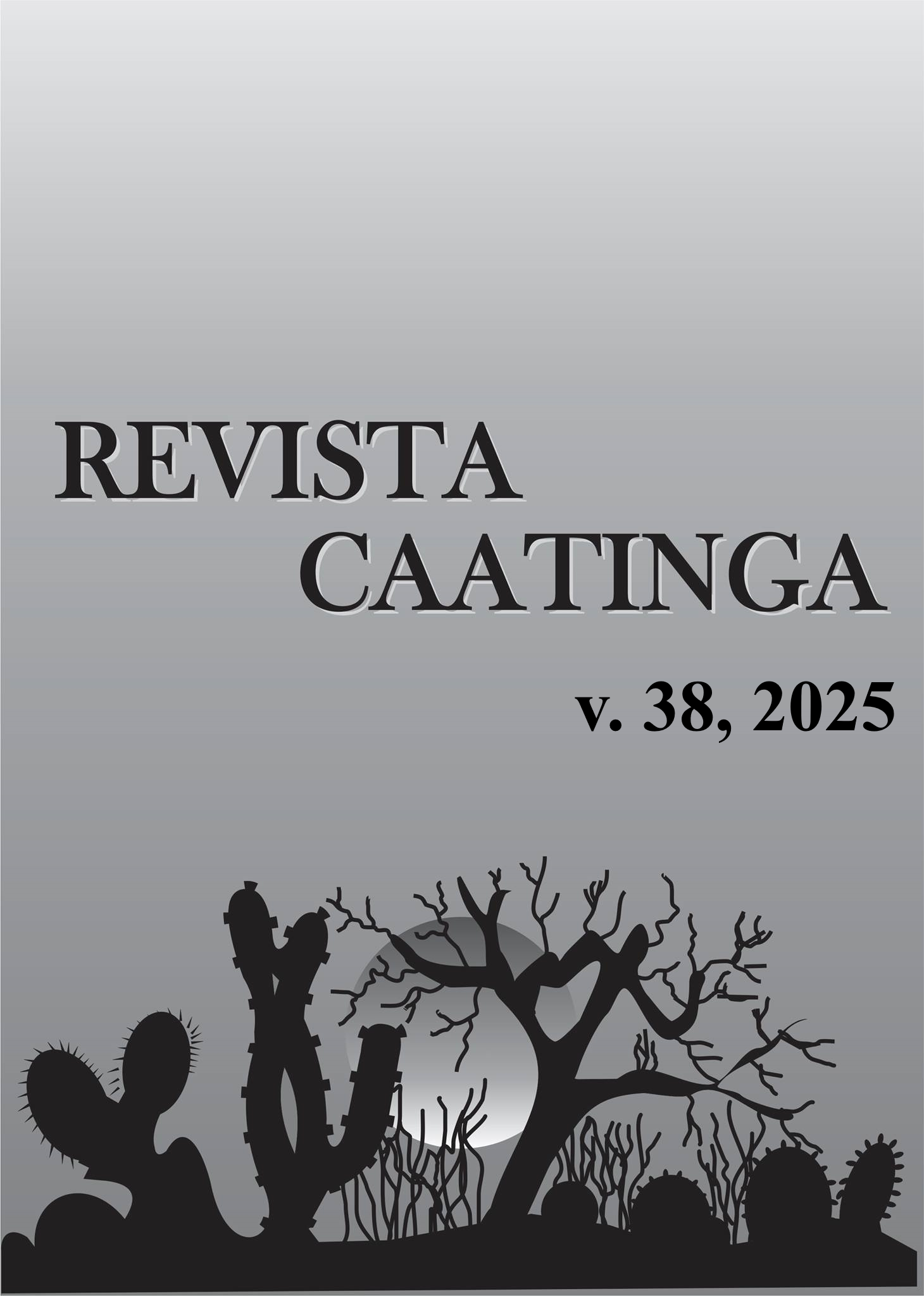Reaction of two melon hybrids to Macrophomina phaseolina and M. pseudophaseolina
DOI:
https://doi.org/10.1590/1983-21252025v3812875rcKeywords:
Cucumis melo. Disease severity. Incidence. Root pathogen.Abstract
Macrophomina phaseolina is a major phytopathogen linked to root rot and vine decline in melon plants in northeastern Brazil. Managing this pathogen is difficult due to its polyphagous nature and adaptation to the semi-arid conditions of the region. In this study, we inoculated 10 isolates each of M. phaseolina (Ph) and M. pseudophaseolina (Ps) onto two melon hybrids, 'Beloro' and ‘Natal RZ’, to assess their pathogenicity. Sixty days post-planting, we measured disease incidence (INC) and severity (SEV), shoot (SL) and root length (RL), fresh shoot and root weight (FSW and FRW), and dry shoot and root weight (DSW and DRW). The hybrid 'Beloro' exhibited a 100% INC across all tested isolates. The ‘Natal RZ’ hybrid showed INC ranging from 14.3 to 100.0%, with the Ph-A6P5 and Ps-A10P16 isolates causing no disease (INC and SEV of 0.0). Average SEV indicated that Ph isolates were more aggressive, causing severe damage to both 'Beloro' (4.58) and ‘Natal RZ’ (3.18), compared to Ps isolates, which showed lower severity scores in 'Beloro' (2.56) and ‘Natal RZ’ (0.70). Given the limited information on the pathogenicity of Ps in melon, further research is essential to determine the infectious potential of this fungus.
Downloads
References
ABD-ELSALAM, K. A. Genetical and biological control of cotton ashy stem caused by Macrophomina phaseolina in outdoor pot experiment. Saudi Journal of Biological Sciences, 17: 147-152, 2010.
AGROFIT - Sistema de Agrotóxicos Fitossanitários, do Ministério da Agricultura, Pecuária e Abastecimento. Consulta Aberta. Available at: <https://agrofit.agricultura.gov.br/agrofit_cons/principal_agrofit_cons>. Access on: Jun. 2, 2024.
ALVARES, C. A. et al. Köppen’s climate classification map for Brazil. Meteorologische Zeitschrif, 22: 711-728, 2014.
AMBRÓSIO, M. M. Q. et al. Screening a variable germplasm collection of Cucumis melo L. for seedling resistance to Macrophomina phaseolina. Euphytica, 206: 287-300, 2015.
BAKHSHI, E.; SAFAIE, N.; SHAMS-BAKHSH, N. Bacillus amyloliquefaciens as a biocontrol agent improves the management of charcoal root rot in melon. Journal of Agricultural Science and Technology, 20: 597-607, 2018.
CASTRO, G. et al. Resistance in melon to Monosporascus cannonballus and M. eutypoides: Fungal pathogens associated with Monosporascus root rot and vine decline. Annals of Applied Biology, 177: 101-111, 2020.
CAVALCANTE, A. L. A. et al. Characterization of Five New Monosporascus Species: Adaptation to Environmental Factors, Pathogenicity to Cucurbits and Sensitivity to Fungicides. Journal of Fungi, 6: 1-14, 2020.
COSTA, T. E. et al. Genetic similarity of Macrophomina pseudophaseolina isolates associated with weeds in the Brazilian semiarid region. Revista Caatinga, 33: 908-917, 2020.
FARR, D. F.; ROSSMAN, A. Y. Fungal Databases, U.S. National Fungus Collections, ARS, USDA. Available at: <https://nt.ars-grin.gov/fungaldatabases>. Access on: Mar. 3, 2023.
FIGUERÊDO, M. C. B.; GONDIM, R. S.; ARAGÃO, F. A. S. Produção de melão e mudanças climáticas: sistemas conservacionistas de cultivo para redução das pegadas de carbono e hídrica. 1. ed. Brasília, DF: Embrapa, 2017. 302 p.
IBGE – Instituto Brasileiro de Geografia e Estatística. Produção Agrícola Municipal. Available at: <http://www.sidra.ibge.gov.br>. Access on: Oct. 15, 2022.
IQBAL, U.; MUKHTAR, T. Morphological and pathogenic variability among Macrophomina phaseolina isolates associated with mungbean (Vigna radiata L.) Wilczek from Pakistan. The Scientific World Journal, 15: 1-9, 2014.
KIST, B.; CARVALHO, C.; BELING, R. R. Anuário Brasileiro de Horti e Fruti. Santa Cruz do Sul, RS: Editora Gazeta Santa Cruz, 2022. 96 p.
LINHARES, C. M. S. et al. Effect of temperature on disease severity of charcoal rot of melons caused by Macrophomina phaseolina: implications for selection of resistance sources. European Journal of Plant Pathology, 158: 431-441, 2020.
LODHA, S.; MAWAR, R. Population dynamics of Macrophomina phaseolina in relation to disease management: A review. Journal of Phytopathology, 168: 1-17, 2019.
MACHADO, A. R.; PINHO, D. B.; PEREIRA, O. L. Bayesian analyses of five gene regions reveal a new phylogenetic species of Macrophomina associated with charcoal rot on oilseed crops in Brazil. European Journal of Plant Pathology, 153: 89-100, 2019.
NEGREIROS, A. M. P. et al. Identification and pathogenicity of Macrophomina species collected from weeds in melon fields in Northeastern Brazil. Journal of Phytopathology, 167: 326-337, 2019.
NEGREIROS, A. M. P. et al. Characterization of adaptability components of Brazilian isolates of Macrophomina pseudophaseolina. Journal of Phytopathology, 168: 490-499, 2020.
POUDEL, B. et al. Hidden diversity of Macrophomina associated with broadacre and horticultural crops in Australia. European Journal of Plant Pathology, 161: 1-23, 2021.
SALES JÚNIOR, R. et al. Pathogenicity of Macrophomina species collected from weeds in cowpea. Revista Caatinga, 33: 395-401, 2020.
SARR, M. P. et al. Genetic diversity in Macrophomina phaseolina, the causal agent of charcoal rot. Phytopathologia Mediterranea, 53: 250-268, 2014.
ZHAO, P. et al. Root colonization process of Arabidopsis thaliana by a fluorescent green protein labeled Verticillium dahliae isolate. Protein & Cell, 5: 94-98, 2014.
ZHAO, L. et al. Macrophomina vaccinii sp. nov. causing blueberry stem blight in China. MycoKeys, 55: 1-14, 2019.
Downloads
Published
Issue
Section
License
Os Autores que publicam na Revista Caatinga concordam com os seguintes termos:
a) Os Autores mantêm os direitos autorais e concedem à revista o direito de primeira publicação, com o trabalho simultaneamente licenciado sob a Licença Creative Commons do tipo atribuição CC-BY, para todo o conteúdo do periódico, exceto onde estiver identificado, que permite o compartilhamento do trabalho com reconhecimento da autoria e publicação inicial nesta revista, sem fins comerciais.
b) Os Autores têm autorização para distribuição não-exclusiva da versão do trabalho publicada nesta revista (ex.: publicar em repositório institucional ou como capítulo de livro), com reconhecimento de autoria e publicação inicial nesta revista.
c) Os Autores têm permissão e são estimulados a publicar e distribuir seu trabalho online (ex.: em repositórios institucionais ou na sua página pessoal) a qualquer ponto antes ou durante o processo editorial, já que isso pode gerar alterações produtivas, bem como aumentar o impacto e a citação do trabalho publicado (Veja O Efeito do Acesso Livre).







